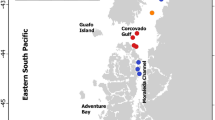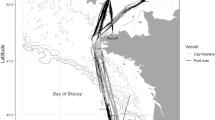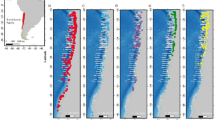Abstract
Understanding interactions between large ships and large whales is important to estimate risks posed to whales by ships. The coastal waters of Alaska are a summer feeding area for humpback whales (Megaptera novaeangliae) as well as a prominent destination for large cruise ships. Lethal collisions between cruise ships and humpback whales have occurred throughout Alaska, including in Glacier Bay National Park (GBNP). Although the National Park Service (NPS) establishes quotas and operating requirements for cruise ships within GBNP in part to minimize ship–whale collisions, no study has quantified ship–whale interactions in the park or in state waters where ship traffic is unregulated. In 2008 and 2009, an observer was placed on ships during 49 different cruises that included entry into GBNP to record distance and bearing of whales that surfaced within 1 km of the ship’s bow. A relative coordinate system was developed in ArcGIS to model the frequency of whale surface events using kernel density. A total of 514 whale surface events were recorded. Although ship–whale interactions were common within GBNP, whales frequently surfaced in front of the bow in waters immediately adjacent to the park (west Icy Strait) where cruise ship traffic is not regulated by the NPS. When ships transited at speeds >13 knots, whales frequently surfaced closer to the ship’s midline and ship’s bow in contrast to speeds slower than 13 knots. Our findings confirm that ship speed is an effective mitigation measure for protecting whales and should be applied to other areas where ship–whale interactions are common.






Similar content being viewed by others
References
ACCOBAMS (2005) Report of the Joint ACCOBAMS/Pelagos Workshop on large whale ship strikes in the Mediterranean Sea. SC/58. Monaco, November 14–15, 2005
Brownell RL Jr, Galletti Vernazzani B, Carlson CA (2009) Vessel collision with a large whale off southern Chile. SC/61/BC7. 61st Annual Meeting of the International Whaling Commission. Maderia, Portugal, June 22–26, 2009
Calambokidis J, Falcone EA, Quinn TJ, Burdin AM, Clapham PJ, Ford JKB et al (2008) SPLASH: structure of populations, levels of abundance and status of Humpback Whales in the North Pacific. Final report to United States Department of Commerce for Contract No. AB133F-03-RP-00078. Cascadia Research, Olympia, WA
Carrillo M, Ritter F (2010) Increasing numbers of ship strikes in the Canary Islands: proposals for immediate action to decrease risk of vessel-whale collisions. Journal of Cetacean Research and Management 11:131–138
Cruise Lines International Association (2010) 2010 CLIA cruise market overview. Available at: http://www.cruising.org. Accessed 1 June 2010
Doherty JL, Gabriele CM (2001) Population characteristics of humpback whales in Glacier Bay and adjacent waters: 2001. Report to the National Park Service, Gustavus, AK, 24 pp
Doherty JL, Gabriele CM (2004) Results of humpback whale population monitoring in Glacier Bay and adjacent waters: 2004. Report to the National Park Service, Gustavus, AK, 26 pp
Environmental Systems Research Institute, Inc. (2008) ArcGIS 9.3. Available at: http://www.esri.com/. Accessed 1 April 2008
Federal Register (2006, November 30) Glacier Bay National Park, vessel management plan regulations. National Park Service, Department of Interior, 69327–69358
Federal Register (2008, December 5) Endangered Fish and Wildlife; final rule to implement speed restrictions to decrease the threat of ship collisions with North Atlantic right whales. National Oceanic and Atmospheric Administration, 74003
Firestone J, Lyons SB, Wang C, Corbett JJ (2008) Statistical modeling of North Atlantic right whale migration along the mid-Atlantic region of the eastern seaboard of the United States. Biological Conservation 141:221–232
Gabriele CM, Jensen AS, Neilson JL, Straley JM (2007) Preliminary summary of reported whale–vessel collisions in Alaskan waters: 1978–2006. SC/59/BC/. 59th Annual Meeting of the International Whaling Commission. Anchorage, Alaska, May 28–31, 2007
Gatrell AC, Bailey TC, Diggle PJ, Rowlingson BS (1996) Spatial point pattern analysis and its application in medical geography. Transactions of the Institute of British Geographers 21:256–274
Gende SM (2007) Understanding how cruise ships affect resources and visitor experiences in Glacier Bay National Park and Preserve. Alaska Park Science 7:22–27
Hoyt E (2005) Marine protected areas for whales, dolphins, and porpoises: a world handbook for cetacean habitat conservation. Cromwell Press Ltd., Trowbridge
Jensen AS, Silber GK (2003) Large whale ship strike database. NMFS-F/OPR-25. NOAA Technical Memorandum. United States Department of Commerce, Silver Spring
Kipple BM (2002) Southeast Alaska cruise ship underwater acoustic noise. NSWCCD-71-TR-2004/521. NPS Technical Report. Naval Surface Warfare Center–Detachment, Bremerton, WA
Knowlton AR, Kraus SD (2001) Mortality and serious injury of northern right whales (Eubalaena glacialis) in the western North Atlantic Ocean. Journal of Cetacean and Research Management (Special Issue) 2:193–208
Laist DW, Knowlton AR, Mead JG, Collet AS, Podesta M (2001) Collisions between ships and whales. Marine Mammal Science 17:35–75
McGarigal K, Marks BJ (1995) FRAGSTATS: Spatial pattern analysis program for quantifying landscape structure. PNW-GTR-351. General Technical Report. United States Department of Agriculture, Forest Service, Pacific Northwest Research Station, Portland, OR
McGarigal K, Cushman SA, Neel MC, Ene E (2002) FRAGSTATS: Spatial Pattern Analysis Program for Categorical Maps. Computer software program produced by the authors at the University of Massachusetts, Amherst. MA. Available at: www.umass.edu/landeco/research/fragstats/fragstats.html. Accessed 1 October 2009
Merrick RL, Cole TVN (2007) Evaluation of northern right whale ship strike reduction measures in the Great South Channel of Massachusetts. NMFS/NE-202. NOAA Technical Memorandum. United States Department of Commerce, Silver Spring, MD
Minnesota Department of Natural Resources (2001) DNR Garmin. Available at: http://www.dnr.state.mn.us/mis/gis/tools/arcview/extensions/DNRGarmin/DNRGarmin.html. Accessed 1 April 2008
National Marine Fisheries Service (NMFS) (2001) Environmental Assessment/Regulatory Impact Review/Final Regulatory Flexibility Analysis (EA/RIR/FRFA) for a Regulatory Amendment to Implement Minimum Approach Distances Around Humpback Whales in Waters off Alaska. NMFS, Protected Resources Division, Alaska Region
National Park Service (2003) Glacier Bay National Park and Preserve Vessel Quotas and Operating Requirements Final Environmental Impact Statement. National Park Service Department of the Interior, National Park Service, Alaska Division
National Research Council of the National Park Service National Academies (2005) Marine mammal populations and ocean noise: determining when noise causes biologically significant effects. National Academies Press, Washington, DC
Nielson JL, Gabriele CM (2009) Results of humpback whale monitoring in Glacier Bay, adjacent waters. Report to the National Park Service. Glacier Bay National Park and Preserve, Gustavus, AK
Nowacek DP, Johnson MP, Tyack PL (2003) North Atlantic right whales (Eubalaena glacialis) ignore ships but respond to alerting stimuli. Proceedings of the Royal Society London B 271:227–231
Nowacek DP, Thorne LH, Johnstone DW, Tyack PL (2007) Responses of cetaceans to anthropogenic noise. Mammal Review 37:81–115
O’Neill RV, DeAngelis DL, Waide JB, Allen TFH (1986) A hierarchical concept of ecosystem. Princeton University Press, Princeton
Panigada S, Pesante G, Zanardelli M, Capoulade F, Gannier A, Weinrich MT (2006) Mediterranean fin whales at risk from fatal ship strikes. Marine Pollution Bulletin 52:1287–1298
Silber GK, Slutsky J, Bettridge S (2010) Hydrodynamics of a ship/whale collision. Journal of Experimental Marine Biology and Ecology 391:10–19
Silverman BW (1986) Density estimation for statistics and data analysis. Chapman & Hall, New York
Southall BL (2005) Shipping noise and marine mammals: a forum for science, management, and technology. Final Report of the National Oceanic and Atmospheric Administration International Symposium. United States NOAA Fisheries, Arlington, VA, May 18–19, 2004
Southall BL, Scholik-Schlomer A (2008) Potential application of vessel-quieting technology on large commercial vessels. Final report of the National Oceanic and Atmospheric Administration International Conference. United States NOAA, Silver Spring, MD, May 1–2, 2007
Southall BL, Bowles AE, Ellison WT, Finneran JJ, Gentry RL, Greene CR Jr et al (2007) Marine mammal noise exposure criteria: initial scientific recommendations. Aquatic Mammals 33:411–521
Urban DL, O’Neill RV, Shugart HH Jr (1987) A hierarchical perspective can help scientists understand spatial patterns. Bioscience 37:119–127
Vanderlaan ASM, Taggart CT (2007) Vessel collisions with whales: the probability of lethal injury based on vessel speed. Marine Mammal Science 23:144–156
Ward-Geiger LI, Silber GK, Baumstark RD, Pulfer TL (2005) Characterization of ship traffic in right whale critical habitat. Coastal Management 33:263–278
Wu J (1999) Hierarchy and scaling: extrapolating information along a scaling ladder. Canadian Journal of Remote Sensing 25:367–380
Zerbini AN, Waite JM, Laake JL, Wade PR (2006) Abundance, trends and distribution of baleen whales off Western Alaska and the central Aleutian Islands. Deep Sea Research 53:1772–1790
Acknowledgments
This research was made possible through funding to the University of Washington and the University of Alaska Southeast by the National Fish and Wildlife Foundation, National Park Foundation, NPS, and Pacific Life Foundation. Research was supported by a cooperative agreement between the University of Washington and the NPS through the Pacific Northwest Cooperative Ecosystem Studies Unit. We are grateful to B. Eichenlaub for processing GPS and observer data; N. Drumheller, C. Gabriele, J. L. Neilson, S. Pyare, and J. K. Neilsen for project assistance; P. Karnik, B. Worley, and A. Green for logistical assistance; and to the captain and crew of the Holland America ships Amsterdam, Ryndam, Statendam, Volendam, Zaandam, and Zuiderdam for accommodating this project. C. Gabriele provided helpful comments on earlier drafts of the manuscript. The manuscript was improved by thoughtful comments from P. Clapham and two anonymous reviewers.
Author information
Authors and Affiliations
Corresponding author
Rights and permissions
About this article
Cite this article
Harris, K., Gende, S.M., Logsdon, M.G. et al. Spatial Pattern Analysis of Cruise Ship–Humpback Whale Interactions in and Near Glacier Bay National Park, Alaska. Environmental Management 49, 44–54 (2012). https://doi.org/10.1007/s00267-011-9754-9
Received:
Accepted:
Published:
Issue Date:
DOI: https://doi.org/10.1007/s00267-011-9754-9




